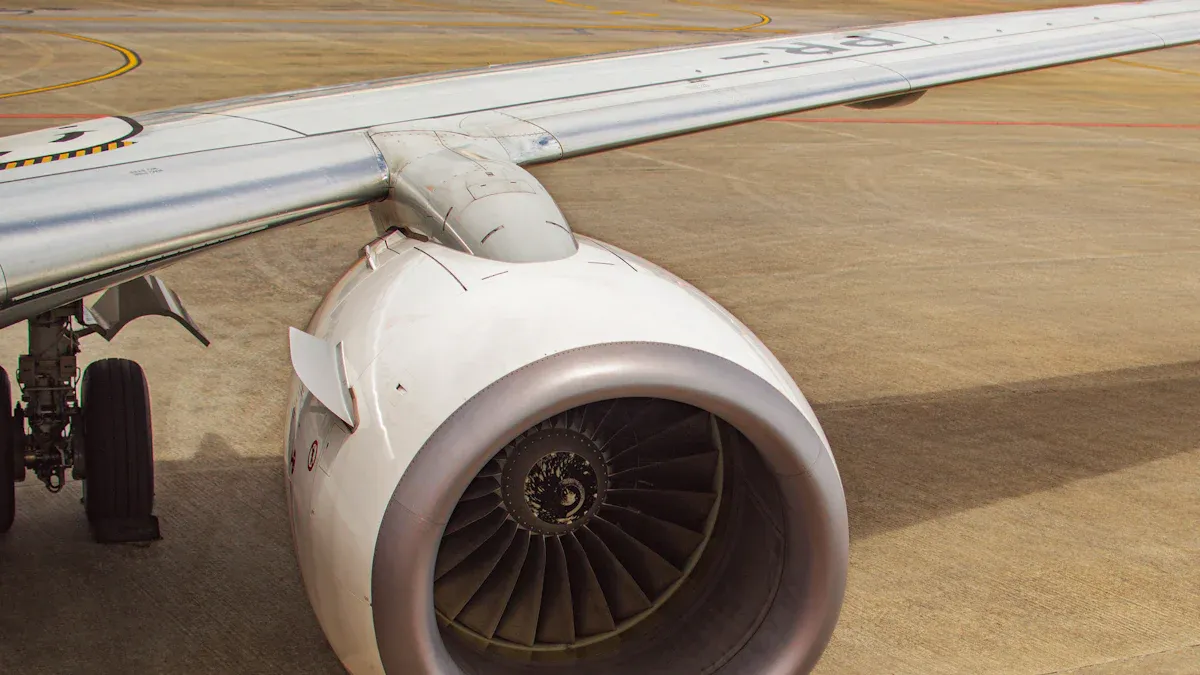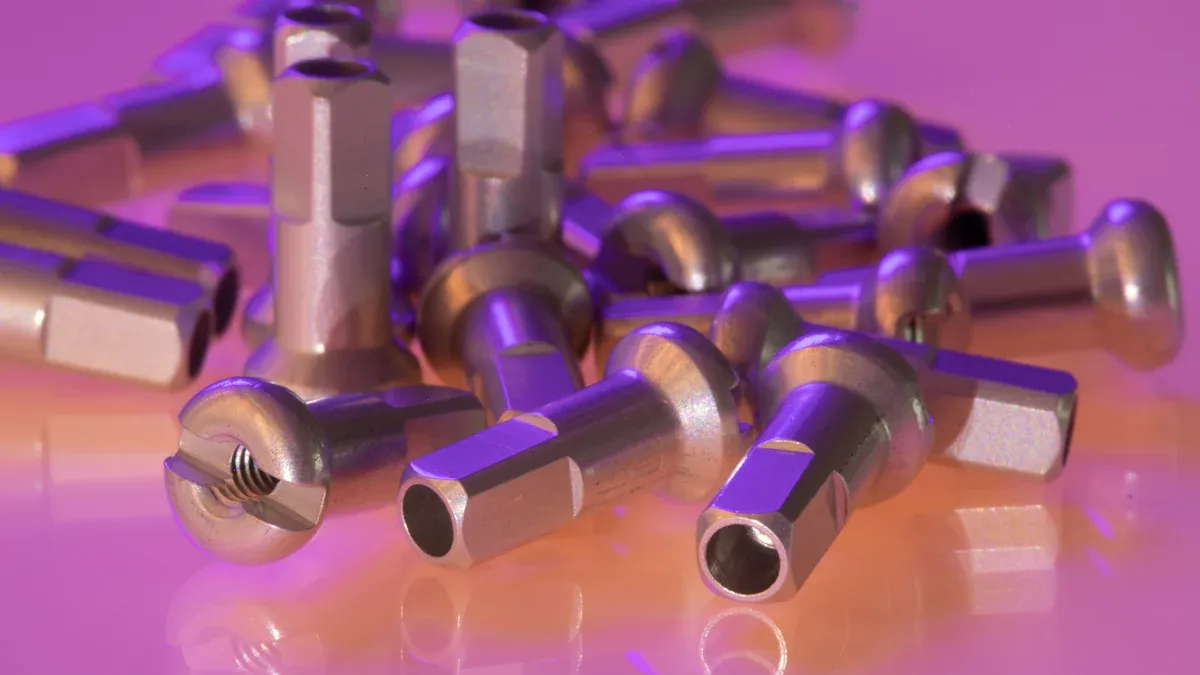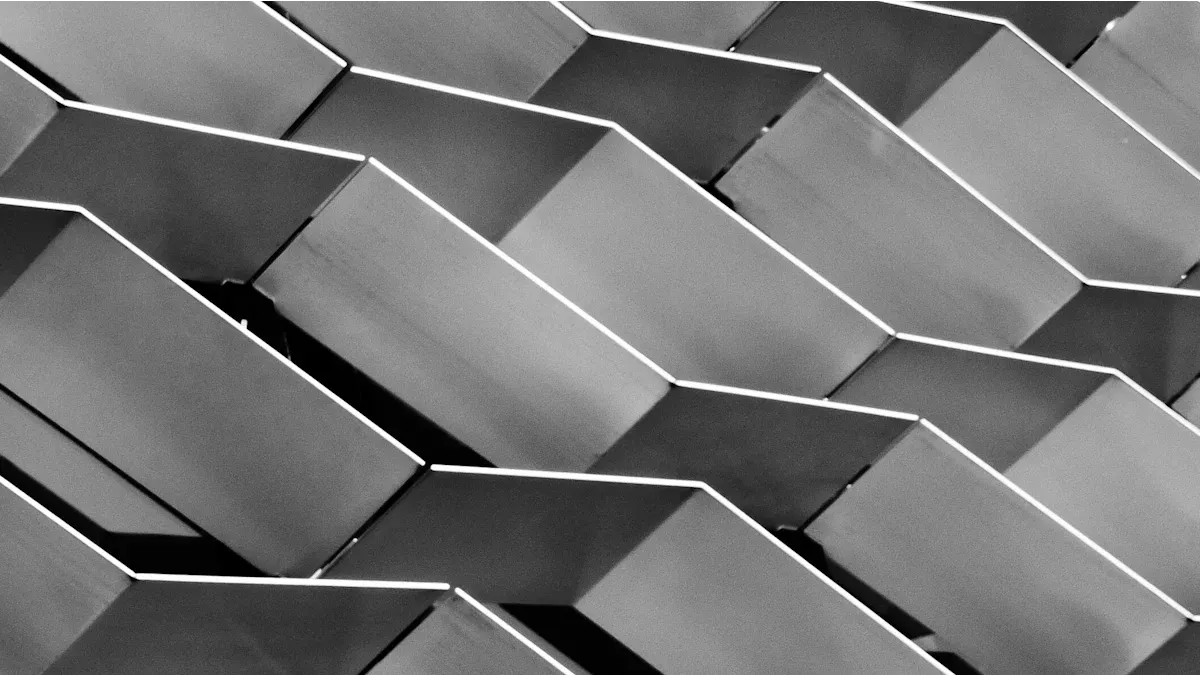
Selecting the best surface treatments for aerospace-grade titanium components significantly enhances their performance and longevity. Various treatments, such as anodizing and shot peening, lead to improved mechanical strength, increased wear resistance, and enhanced fatigue life. Peer-reviewed studies indicate that surface treatments can elevate shear strength, optimize residual stress distribution, and ultimately ensure reliability in demanding aerospace environments.
Key Takeaways
- Selecting the right surface treatment enhances the performance and longevity of aerospace-grade titanium components.
- Anodizing improves corrosion resistance and wear properties, making it essential for durability in harsh environments.
- Shot peening increases fatigue strength and crack resistance by inducing compressive residual stresses on titanium surfaces.
- Plasma spray coating significantly enhances wear and oxidation resistance, ensuring components withstand extreme conditions.
- Chemical Vapor Deposition (CVD) produces coatings with exceptional hardness, ideal for improving safety and reliability in aerospace applications.
- Physical Vapor Deposition (PVD) enhances surface hardness and wear resistance, leading to longer service life for titanium components.
- Surface hardening techniques, like nitriding, increase hardness and wear resistance, crucial for high-stress applications.
- Sustainability is becoming a priority in surface treatments, with innovations focusing on eco-friendly materials and processes.
Overview of Aerospace-Grade Titanium
Properties of Titanium
Aerospace-grade titanium possesses unique properties that make it a preferred material in the aerospace industry. Its high strength-to-weight ratio stands out, as titanium is comparable to steel in strength but significantly lighter—about 45% less. This characteristic is crucial for improving fuel economy and payload capacity in aerospace designs.
Moreover, titanium exhibits excellent corrosion resistance, allowing it to withstand harsh environmental conditions. This property enhances the reliability of components and reduces maintenance costs. The material also demonstrates superior fatigue strength, enabling it to endure cyclical loading without fracturing. This quality is vital for critical structural applications where safety is paramount. Additionally, titanium maintains its structural integrity across a wide temperature range, making it suitable for components in jet engines and hypersonic flight.
Recent studies highlight that the mechanical and chemical properties of aerospace-grade titanium are significantly influenced by surface treatments. Factors such as surface roughness and electroactive area play critical roles. Different treatments, including mechanical abrasion and various chemical processes, affect surface morphology, adhesion, and corrosion resistance. Notably, oxalic acid treatment resulted in the largest electroactive area and roughness factor, indicating its effectiveness in enhancing the material’s properties for aerospace applications.
Importance in Aerospace Applications
The importance of titanium in aerospace applications cannot be overstated. Industry experts emphasize several key reasons for its preference over other metals:
- High Strength-to-Weight Ratio: This property is essential for improving fuel efficiency and overall performance.
- Excellent Corrosion Resistance: It ensures longevity and reliability in various environmental conditions.
- Superior Fatigue Strength: This allows components to withstand repeated stress without failure.
- Elevated Operational Temperature Range: Titanium maintains its integrity under extreme temperatures, crucial for aerospace components.
Titanium’s unmatched strength-to-weight ratio, corrosion resistance, and high-temperature tolerance make it ideal for aerospace components. As the aerospace industry continues to evolve, the demand for materials that can withstand rigorous conditions while maintaining performance will only increase.
Surface Treatments for Titanium

Anodizing
Anodizing is a widely used surface treatment for aerospace-grade titanium. This electrochemical process creates a protective oxide layer on the titanium surface, enhancing its corrosion resistance and wear properties. The anodizing process involves several parameters that significantly influence the resulting surface characteristics.
| Parameter | Typical Value/Range | Resulting Surface Characteristic |
|---|---|---|
| Voltage | 15 to 120 volts | Affects oxide layer thickness and color |
| Current Density | 15 to 30 amps per square foot | Ensures uniform oxide layer formation |
| Temperature | 60 to 75 degrees Fahrenheit | Optimizes anodizing reaction |
| Post-treatment | Hot deionized water or nickel acetate solution | Seals and protects oxide layer |
Anodizing not only improves corrosion resistance but also enhances fatigue life. Research indicates that anodizing techniques, such as sodium tartrate anodizing, provide environmentally friendly options that maintain mechanical properties. Studies show that while traditional acid anodizing can increase hydrogen content and reduce fatigue life, sodium tartrate anodizing has minimal impact on these properties. This makes anodizing a vital treatment for ensuring the longevity of titanium components in aerospace applications.
Shot Peening
Shot peening is another effective surface treatment for titanium components. This mechanical process involves bombarding the surface with small spherical media, which induces compressive residual stresses. These stresses enhance the fatigue strength and crack resistance of titanium alloys, making them more suitable for demanding aerospace environments.
| Parameter | Description |
|---|---|
| Impact Angle | Compressive stresses are introduced in the surface layer, enhancing fatigue life and resistance to cracking. |
| Coverage Area | The extent of the surface area that is treated during the shot peening process. |
| Almen Intensity Levels | A measure of the intensity of the shot peening process, influencing the resulting surface properties. |
| Surface Roughness | Changes in the texture of the titanium surface post-peening can affect fatigue resistance. |
| Microhardness | The hardness of the surface layer increases due to the shot peening process. |
| Residual Stresses | Compressive stresses introduced in the surface layer, enhancing fatigue life and resistance to cracking. |
Shot peening increases surface roughness and microhardness, contributing to improved fatigue resistance. It is particularly beneficial after machining or heat treatments, as it prevents crack propagation. The technique has been successfully applied to various aerospace components, including connecting rods and crankshafts, demonstrating its effectiveness in enhancing performance.
Plasma Spray Coating
Plasma spray coating is a versatile surface treatment that applies a layer of material onto titanium components. This method involves heating a feedstock material to a molten state and then spraying it onto the substrate. Plasma spray coatings can significantly improve wear and oxidation resistance, making them ideal for aerospace applications.
| Coating Material | Performance Improvements |
|---|---|
| Titanium oxide coatings | Enhanced wear resistance, corrosion resistance, improved mechanical properties |
| Titanium coatings | Biocompatibility, reduced stress at the implant-bone interface due to lower elastic modulus |
Various techniques, such as oxyacetylene flame spraying, arc spraying, and plasma spraying, are employed to achieve desired coating properties. The plasma-sprayed graphene reinforced titanium nitride composite coating, for instance, demonstrates significant wear and oxidation resistance, effectively mitigating corrosion attacks. This capability is crucial for maintaining the integrity of aerospace components under extreme conditions.
Chemical Vapor Deposition (CVD)
Chemical Vapor Deposition (CVD) is a sophisticated technique used to apply thin films on titanium surfaces. This process involves chemical reactions that occur in a vapor phase, leading to the deposition of materials onto the substrate. CVD coatings, particularly titanium nitride (TiN), are renowned for their exceptional hardness, wear resistance, and chemical stability. These characteristics make TiN an ideal choice for aerospace components, contributing to improved safety and reliability while also reducing maintenance costs.
The typical process conditions for CVD on titanium include several critical steps:
- Substrate Preparation: Clean and activate the titanium surface to ensure optimal adhesion and film quality.
- Chamber Environment Setup: Establish the required temperature and pressure conditions with appropriate process gases.
- Precursor Introduction: Deliver precursor materials in a controlled manner using inert carrier gases.
- Gas-Phase Reactions: Facilitate the formation of intermediate species through chemical reactions involving the precursors.
- Surface Reactions: Allow diffusion and reaction of species at the substrate surface.
- Film Growth: Control the buildup of material to form uniform coating layers.
- Process Completion: Remove byproducts and cool down the system, including any necessary post-processing.
CVD coatings generally provide higher hardness levels than PVD coatings. For instance, TiAlN coatings can achieve around 2,800 HV, while TiN reaches approximately 2,300 HV. The thicker application of CVD coatings also contributes to better corrosion resistance, making them more effective in harsh environments. CVD coatings protect jet engine components against high temperatures, provide resistance to oxidation and corrosion, and enhance overall component performance and longevity.
Physical Vapor Deposition (PVD)
Physical Vapor Deposition (PVD) is another critical surface treatment method for titanium components in aerospace applications. PVD involves the physical transfer of material from a solid or liquid source to the substrate, forming a thin film. Various PVD techniques are employed, each with specific applications:
| PVD Technique | Description | Typical Applications |
|---|---|---|
| Thermal Evaporation Deposition | Simple method where source material is heated until it evaporates. | Optical coatings, aerospace components |
| Electron-Beam PVD (EBPVD) | Uses focused electron beam to evaporate source material. | Aerospace components, advanced optics |
| Sputtering Deposition | Bombards target material with energetic particles to form a thin film. | Semiconductor manufacturing, advanced electronics |
| Pulsed Laser Deposition (PLD) | Employs high-power laser pulses to ablate material from the target. | High-temperature superconductors, ceramics |
| Cathodic Arc Evaporation | Creates highly ionized plasma for coating deposition. | Wear-resistant coatings for tools and components |
PVD coatings significantly improve surface hardness and wear resistance of aerospace-grade titanium. For example, PVD treatments can enhance service life by up to 125%, resulting in longer intervals between overhauls. The coatings also reduce oxidation-related degradation by 80% and improve erosion resistance by 60%. These enhancements contribute to the reliability and efficiency of aerospace components.
Surface Hardening Techniques
Surface hardening techniques play a vital role in enhancing the performance of titanium components in aerospace applications. These methods increase surface hardness and wear resistance, which are crucial for components subjected to high stress and fatigue.
- Plasma Nitriding: This technique involves implanting nitrogen ions into the titanium surface, forming titanium nitride (TiN). This process significantly increases hardness, achieving levels around 2000 HV. The characteristic gold color of the treated surface indicates the presence of TiN, which enhances tribological performance.
- Gas Nitriding: Similar to plasma nitriding, this method diffuses nitrogen onto the titanium surface, forming a hard layer of titanium nitride. This treatment improves abrasion resistance and reduces the coefficient of friction.
- Laser Nitriding: This advanced technique uses laser energy to create a hard surface layer. It effectively modifies the microstructure of titanium, leading to improved fatigue life and service intervals.
Surface hardening techniques, particularly laser-assisted ultrasonic nanocrystal surface modification (LA-UNSM), significantly enhance the microstructure of aerospace-grade titanium parts. These techniques introduce substantial compressive residual stress and refine the surface layer, leading to improved fatigue performance and increased resistance to crack growth. This enhancement in material properties directly correlates with extended fatigue life and longer service intervals for titanium alloys used in aerospace applications.
Comparison of Surface Treatments

Effectiveness
When evaluating the effectiveness of various surface treatments for aerospace-grade titanium, several factors come into play, including corrosion resistance, wear resistance, and fatigue life. The following table summarizes the effectiveness rates of different treatments:
| Surface Treatment | Corrosion Resistance | Wear Resistance | Fatigue Life |
|---|---|---|---|
| Anodic Oxidation | High | 4-6 times less wear than untreated | N/A |
| CVD | Moderate | N/A | N/A |
| PVD | Moderate | N/A | N/A |
| Nitriding | High | N/A | N/A |
| Anodization | High | Improved with rutile phase | N/A |
Anodic oxidation and nitriding stand out for their high corrosion resistance, making them suitable for components exposed to harsh environments. In contrast, CVD and PVD treatments offer moderate effectiveness but excel in specific applications where wear resistance is critical.
Cost Considerations
Cost plays a significant role in selecting surface treatments for titanium components. The initial investment and lifecycle costs can vary widely among different methods. The following table outlines the cost considerations for various treatments:
| Surface Treatment | Initial Cost Comparison | Lifecycle Cost Reduction | Durability Comparison |
|---|---|---|---|
| PVD Coatings | 30–50% more than anodizing | N/A | Lasts 3–5 times longer in high-wear applications |
| TripleHard® Trivalent Chromium Plating | Higher upfront cost | 30–55% compared to hexavalent chrome | N/A |
| Anodizing | Low material and energy requirements | N/A | Cost-effective for large-batch components |
While PVD coatings require a higher initial investment, their durability in high-wear applications can lead to significant lifecycle cost reductions. Anodizing remains a cost-effective option for large-scale production due to its low material and energy requirements.
Longevity and Maintenance
The longevity and maintenance requirements of surface treatments also differ significantly. Regular maintenance ensures optimal performance and extends the lifespan of treated components. The following table summarizes the maintenance requirements for various surface treatments:
| Surface Treatment Type | Maintenance Requirements |
|---|---|
| General Coatings | Regular inspections, cleaning, and maintenance records are essential for longevity. |
| Titanium Cadmium Plating | Routine maintenance and adherence to best practices are critical for optimal performance. |
- Routine maintenance is essential for titanium cadmium-plated components.
- Following best industry practices ensures extended durability and performance.
Future Trends in Surface Treatments
Innovations in Aerospace Materials
The aerospace industry continually seeks advancements in materials and surface treatments to enhance the performance of titanium components. Recent innovations focus on high-strength, lightweight titanium alloys, such as Ti-6Al-4V and Ti-5Al-2.5Sn. These materials demand advanced surface treatment techniques to improve their mechanical properties and durability. Key innovations include:
- Removal of the Surface Reaction Layer: This process enhances the physical and chemical properties of titanium forgings. Recommended methods include:
- Sandblasting Treatment: Utilizes white corundum abrasive with controlled pressure and time to remove contaminants.
- Pickling Treatment: Effectively removes the surface reaction layer with minimal contamination, using HF-HCl or HF-HNO3 systems.
- Hydrojet Surface Treatment: This method focuses on the Ti-6Al-4V titanium alloy, crucial for aerospace and medical applications. Notable aspects include:
- Additive Manufacturing: Techniques like selective laser melting (SLM) improve component quality and mechanical properties.
- Surface Finishing Methods: Laser polishing and abrasive fluidized bed machining enhance surface quality and fatigue life.
- Surface Treatment Innovations: These methods ensure high quality in aerospace components. Noteworthy techniques include:
- Laser Polishing: Reduces surface roughness and improves wear and corrosion resistance.
- Abrasive Fluidized Bed Machining: Produces smoother surfaces and enhances fatigue life through compressive stresses.
Sustainability Considerations
Sustainability remains a critical concern in the aerospace industry, particularly regarding surface treatments for titanium components. Current practices face several challenges that require attention:
| Challenge | Description |
|---|---|
| Environmental Impact of MWFs | Mineral oil-based metalworking fluids (MWFs) are harmful to the environment and require careful handling. |
| Energy Consumption | MWFs contribute to higher energy consumption, accounting for about 17% of overall production expenses. |
| Health Risks | MWFs pose risks to machine operators, necessitating additional infrastructure for health protection. |
Additionally, the extraction and processing of titanium present sustainability challenges. These include:
- High energy consumption and greenhouse gas emissions during titanium extraction.
- Use of chlorine in refining, leading to harmful pollutants.
- Waste generation, including slag and dust, requiring sustainable management.
Addressing these challenges will be essential for the aerospace industry as it moves toward more sustainable practices in surface treatments. Innovations in eco-friendly materials and processes will play a vital role in shaping the future of aerospace-grade titanium components.
Selecting the right surface treatment for aerospace-grade titanium components is crucial for ensuring performance and longevity. Key factors to consider include:
| Factor | Description |
|---|---|
| Operational Environment | Consider temperature, humidity, and chemical exposure. For example, high-altitude requires heat-resistant coatings like TiAlSiN. |
| Performance Requirements | Mechanical performance varies; landing gear benefits from vacuum nitriding for impact resistance. |
| Cost-Benefit Analysis | Initial costs differ; PVD coatings are more expensive but last longer, while anodizing is cost-effective for large batches. |
| Compatibility with Processes | Treatments like vacuum nitriding must follow machining to avoid distortion; anodizing requires pre-cleaning to prevent defects. |
The future of surface treatments in aerospace applications looks promising. Industry trends indicate a shift towards:
- Eco-friendly alternatives, such as water-based and bio-derived coatings.
- Advanced surface engineering technologies, including laser modification and nanocoating.
- Integration of digital tools for real-time monitoring and optimization.
As the aerospace industry evolves, these innovations will enhance the performance and sustainability of titanium components.
FAQ
What is the primary benefit of anodizing titanium?
Anodizing titanium enhances corrosion resistance and wear properties. This electrochemical process creates a protective oxide layer, significantly improving the material’s durability in harsh environments.
How does shot peening improve titanium components?
Shot peening induces compressive residual stresses on titanium surfaces. This mechanical treatment enhances fatigue strength and crack resistance, making components more reliable in demanding aerospace applications.
What are the advantages of plasma spray coating?
Plasma spray coating improves wear and oxidation resistance. This versatile treatment applies a protective layer, ensuring titanium components withstand extreme conditions while maintaining their mechanical properties.
How does Chemical Vapor Deposition (CVD) work?
CVD involves chemical reactions in a vapor phase to deposit thin films on titanium surfaces. This method produces coatings with exceptional hardness and wear resistance, ideal for aerospace applications.
What is the difference between PVD and CVD?
PVD uses physical processes to deposit materials, while CVD relies on chemical reactions. Both methods enhance surface properties, but CVD typically offers higher hardness levels and better corrosion resistance.
Why is surface hardening important for titanium?
Surface hardening techniques increase the hardness and wear resistance of titanium components. These enhancements are crucial for parts subjected to high stress and fatigue, ensuring longevity and reliability.
Are there eco-friendly surface treatment options available?
Yes, the aerospace industry is exploring eco-friendly surface treatments. Innovations include water-based coatings and sustainable practices that minimize environmental impact while maintaining performance.
How do I choose the right surface treatment for my application?
Consider factors such as operational environment, performance requirements, and cost. Each treatment offers unique benefits, so assess your specific needs to select the most suitable option.

